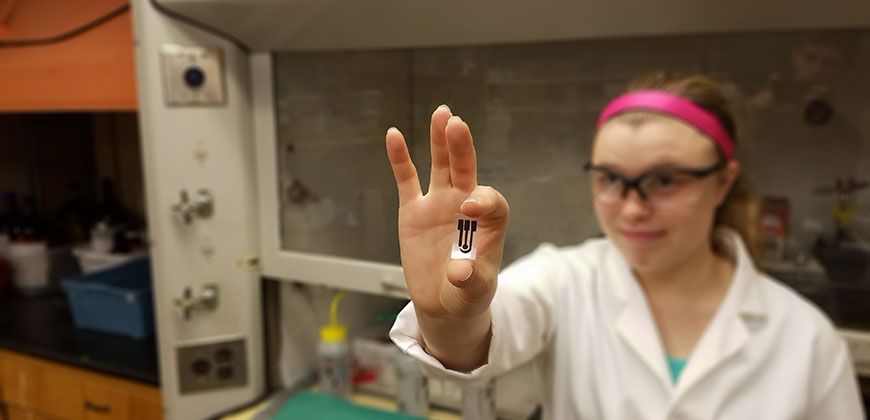
Caption: Katherine Boehle, a chemistry graduate student in Chuck Henry’s lab, holds an electrochemical test strip that can detect harmful bacteria. Credit: Colorado State University
Researchers have discovered a new way to detect food-and-water-borne bacteria.
A team of scientists from Colorado State University have used a combination of color-changing paper and electrochemical analysis on plastic transparency sheets to quickly, cheaply and more accurately detect bacterial contamination of fruits and vegetables in the field before they hit the market.
Bacteria causes the most hospitalizations and deaths in the U.S. of all the contaminants found in food and water, with about half of the incidents attributed to spinach, cabbage, lettuce and other leafy greens that are sometimes irrigated with unsafe water containing fecal material.
The scientists targeted a broad class of bacteria called fecal indicator bacteria, which causes the highest number of hospitalizations and deaths from food poisoning.
While federal regulations require frequent testing of fruits and vegetables for bacterial contamination, traditional lab cultures take up to 48 hours to produce results. Other techniques including DNA amplification and immunoassays are costly and are prone to false results.
In the latest study, a team led by professor Charles Henry simulated contaminated food by exposing clean alfalfa sprouts to E. coli and Enterococcus faecalis bacteria.
The team built a simple light box that substituted for a laboratory plater reader for colorimetric detection.
They also used a smartphone to take a series of images of the 84 paper-based well plates over time. For the electrochemical portion of the experiment, the team used a series of electrodes printed onto plastic transparency sheets.
Both of these methods used the same assays to successfully detect bacteria in the samples within four to 12 hours and both produced complementary findings.
“We found that with filter paper, wax and a little bit pf packing tape, we can do quite a bit of chemistry on here,” Henry said in a statement. “That’s about two-cents worth of materials.”
According to Henry, the next step is to build a mobile computing platform for the tests. They are working on a Raspberry Pi-based system that could perform kinetic measurements to detect changes in the bacteria levels over time and automatically transmit the information to a cloud platform.
The study was published Analytical Chemistry.




